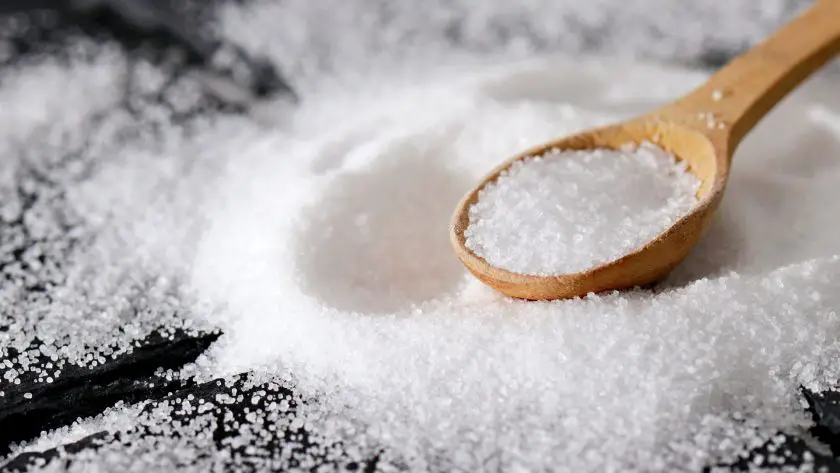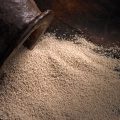For sourdough enthusiasts, salt selection impacts far beyond mere seasoning. The right salt transforms simple loaves into masterpieces. Yet many bakers grab whichever salt sits on the pantry shelf without considering how textures and mineral contents affect flavor, nutrition, and crumb. Does your sourdough lack depth of taste? Do uniform crystals over-tighten your loaf’s crumb? This guide explores common types of salt for sourdough bread, equipping you with the knowledge to enhance texture, boost nutrition, and uncover your bread’s full potential. Forget plain old table salt – let us unlock the secret powers of gourmet salts for your next sourdough creation.

Table of Contents
- Table Salt
- Sea Salt
- Himalayan Pink Salt
- Rock Salt
- Iodized Salt
- Comparison of Salts
- Salt Matters in Sourdough!
- Types Of Salt For Sourdough Bread: FAQs
Table Salt
Table salt, also known as common salt, is the type of salt most home bakers likely have stocked in their kitchens. This highly processed salt is very fine and uniform in texture. The vast majority of table salt sold in the United States is iodized, meaning trace amounts of iodine have been added. Iodine is an important micronutrient that helps regulate metabolism. Many health organizations recommend using iodized table salt over regular sea salt or kosher salt to help prevent iodine deficiency.
When it comes to baking sourdough bread, table salt can certainly get the job done. The fine grains dissolve readily, distributing saltiness evenly throughout the dough. However, some bakers caution that the uniform size and shape of table salt crystals can oversaturate dough during mixing. This can toughen gluten strands, resulting in a tighter crumb structure. For best results, add table salt gradually and with a light hand. Table salt’s convenience and affordability make it a pantry staple for most home cooks. But when crafting artisan loaves, many sourdough enthusiasts prefer the delicate flakes and mineral complexity of premium specialty salts.
- Granulated iodized table salt
- Granulated, iodized, Morton table salt
- This salt supplies iodide, a necessary nutri
Prices pulled from the Amazon Product Advertising API on:
Product prices and availability are accurate as of the date/time indicated and are subject to change. Any price and availability information displayed on [relevant Amazon Site(s), as applicable] at the time of purchase will apply to the purchase of this product.
Sea Salt
Sea salt offers a wealth of benefits and a distinct flavor profile that sets it apart from other salt varieties. With its coarser grains and muted hues, sea salt brings a touch of rugged beauty to handcrafted loaves.
Mineral Content
Compared to highly processed table salt, sea salt is rich in trace minerals from the waters it’s harvested from. These include potassium, iron, and zinc. The mineral content adds subtle nuanced flavors and aroma. When sea salt dissolves into dough, the minerals get absorbed, enriching the final loaf. Sea salt’s mineral complexity makes it a favorite for artisanal bakers seeking to create breads with depth.
Artisanal Appeal
With its delicate crystals and natural provenance, sea salt has an earthy, sun-drenched quality that evokes Old World tradition and craftsmanship. Using sea salt in your recipe adds rustic flair and character to sourdough loaves. Let crumbs dusted with fragrant sea salt transport your senses to an ancient seaside village, where an apron-clad baker pulls steaming artisan loaves from a wood-fired oven.
Coarse, Natural Texture
Unlike highly processed table salt, sea salt has a coarse, chunky texture that provides pleasing crunch and contrast to breads. The salt’s natural irregularity also creates more points of flavor. As your teeth sink into a slice, you get little bursts of briny saltiness. The satisfying crunch and bright taste add dimension that wakes up your palate.
So for bakers seeking a salt that enriches flavor, evokes artisanal appeal, and provides craggy texture, mineral-rich sea salt is a prime choice. Let the subtle perfume of this sun-dried salt transport your loaf to new heights.
- AUTHENTIC, UNPROCESSED – Celtic Sea Salt is authentic, unprocessed whole salt from pristine coastal regions. With a subtle flavor and delicious taste, it’s a great all-purpose salt to keep on hand!
- VERSATILE – Our 8 oz. resealable bag of fine ground Celtic sea salt can be used in a variety of ways – from an all-purpose shaker salt for the table to a recipe ingredient, for baking, pickling and much more. It’s a must-have for your pantry.
- NUTRITIOUS – Our classic salt is more nutritious than table salt, because it retains the natural balance and spectrum of essential minerals, supplying the body with over 74 vital trace minerals & elements. A sprinkle of this sea salt is a healthy addition to any dish or recipe.
- NO ADDITIVES – Our fine ground sea salt is completely all natural and has no additives. It’s not processed in any way beyond low temperature drying and grinding. This salt is also Non-GMO Verified, certified Kosher, lower in sodium than table salt and paleo-friendly.
- ORIGINAL, MOST TRUSTED BRAND – Celtic Sea Salt is the original and most trust brand of sea salt, and is referenced in more culinary and nutritional books and journals than any other salt in the world. Since 1976, we’ve grown into a brand that has been recommended by doctors, nutritionists and chefs alike.
- Low temperature dried and finely ground
- Convenient for Cooking, baking and finishing
- Sustainably hand harvested and Nature et Progres certified
- Naturally lower in sodium than table salt
- Additive free and kosher certif
Prices pulled from the Amazon Product Advertising API on:
Product prices and availability are accurate as of the date/time indicated and are subject to change. Any price and availability information displayed on [relevant Amazon Site(s), as applicable] at the time of purchase will apply to the purchase of this product.
Himalayan Pink Salt
Unique Aspects and Suitability
Mined from the peaks of the Himalayas, this visually striking salt offers artisanal flair that elevates any loaf. Let’s unpack what makes Himalayan pink salt so special.
Vibrant Hue
The salt’s distinctive rosy hue comes from trace minerals like iron and magnesium. These minerals get locked into the salt crystals during formation, imbuing them with a subtle pink tint. When used in bread baking, the pebbles of pink salt add delightful pops of color throughout the crumb. Visually, it’s a feast for the eyes.
Beyond aesthetics, the pink salt’s mineral content also provides some potential health benefits. Minerals like potassium, calcium, and magnesium are essential for regulating various bodily functions. By adding a touch of Himalayan salt to your loaf, you allow bread lovers to sneak in some supplemental minerals with their morning slice.
Subtle, Complex Flavor
In addition to coloring up your crumb, Himalayan pink salt also brings a flavor profile that’s more nuanced than regular table salt. The array of trace minerals provides subtle layered notes that awaken your taste buds. You get a gentle briny saltiness, plus earthy hints of minerals. It’s like taking a bite of the mountain peaks themselves.
The salt’s clean taste and potency mean you can use less of it in your dough. A sprinkling of the bold pink pebbles provides plenty of pop without overpowering the bread’s natural flavor. For bakers seeking salt that delights the eye, intrigues the palate, and adds artisanal identity, pink Himalayan salt is a top contender. Let it bring vibrance and mineral magic to your sourdough creation (which you can start with my beginner sourdough bread recipe!).
Kosher Salt
When it comes to kosher salt, two qualities stand out that make it a top choice for artisan bakers: flake size and texture. Unlike finely ground table salt, kosher salt comes in larger, sturdier flakes. This coarse, craggy texture provides plenty of pros. The irregular flakes take longer to dissolve, allowing the salt to permeate the dough gradually during fermentation. This slower absorption prevents over-salting and tightening of the gluten network.
The hearty flakes also add delightful crunch to the final loaf. As you sink your teeth into a slice, you get pleasant little pops of saltiness rather than an intense all-at-once blast. Beyond texture, the larger grain size means you use less salt by volume. A sprinkling of kosher salt flakes provides the perfect kiss of salty flavor without overpowering the bread.
With its controlled dissolving rate, irregular texture, and popularity among artisan bakers, it’s easy to see why kosher salt is a top choice. Let the sturdy flakes add gradual savor and craggy crunch to your next sourdough creation. But don’t overdo it – a light hand with the kosher salt ensures your loaf rises to its peak potential.
- SEA SALT SUBSTITUTE: Common table salt is refined and many other compounds and additives are added in its processing while Himalayan Pink salt is free from all additives, dyes and preservatives, and without any processing.
- ETHICALLY SOURCED: Pink Himalayan salt is a type of rock salt mined in the depths of the Himalayan mountains of Pakistan. The mineral contents naturally occur in beautiful pink color, making it the highest-quality Himalayan pink salt on the market.
- VERSATILE USE: People use this type of salt and common table salt in the same way: As part of cooking, to season meals, and to preserve food.
- EXPERTLY PRODUCED: SOEOS a renowned spice and herb brand beloved by chefs and culinary enthusiasts bringing bringing fresher ingredients to every kitchen.
- SOEOS takes your satisfaction as our highest priority. Let us know anytime for questions and concerns, as we value your voice to make things rig
Prices pulled from the Amazon Product Advertising API on:
Product prices and availability are accurate as of the date/time indicated and are subject to change. Any price and availability information displayed on [relevant Amazon Site(s), as applicable] at the time of purchase will apply to the purchase of this product.
Rock Salt
With its chunky crystals and eye-catching appearance, rock salt offers intrigue for artisan bakers. But when it comes to sourdough, restraint is advised with this coarse variety.
Potential Use and Caution
Mined from ancient seabeds, rock salt comes in sturdy, irregular chunks that crunch satisfyingly. Some bread bakers sprinkle these nubby crystals on top of loaves for textural flair. The pebbly salt creates little pops of briny flavor and an enticingly rugged crust.
However, rock salt’s extreme coarseness makes it ill-suited for integration into the dough. The large crystals do not adequately dissolve during mixing and fermentation. This prevents even distribution of salty flavor through the crumb. The remaining intact crystals can also damage the gluten network, resulting in a dense loaf.
So while rock salt offers visual allure, reserve it mainly as a finishing salt. A light dusting on top provides craggy decoration without compromising the interior texture. When it comes to salt inside the dough itself, finer varieties that fully incorporate work best. Don’t let rock salt’s chunky charisma lead you astray from salt better suited for the baking process. A compromise of sprinkling a wee bit atop a supremely risen loaf lets you enjoy rock salt’s unique perks.
- KOSHER ROCK SALT - Coarse salt extracted from natural mineral deposits laid down millions of years ago. This salt has a mild, clean flavor and beautifully irregular crystals.
- SUGGESTED USE - Suitable for grinders and cooking. Add to any savory dish to enhance flavor and texture. Use in desserts for a delicate sweet and salty balance.
- COMMITTED TO QUALITY - Falksalt is all natural, NON-GMO, additive free and contains a wide range of trace minerals. Falksalt is handcrafted without artificial flavors and use the highest industry standard quality controls.
- TRADITION - Since 1928, Falksalt has been made using the same traditional artisan methods to produce the best salt that money can buy. Our master salt makers are the most experienced in the industry, resulting in superior gourmet produc
Prices pulled from the Amazon Product Advertising API on:
Product prices and availability are accurate as of the date/time indicated and are subject to change. Any price and availability information displayed on [relevant Amazon Site(s), as applicable] at the time of purchase will apply to the purchase of this product.
Iodized Salt
When it comes to iodized salt, some sourdough bakers have reservations. Will the iodine negatively affect fermentation? Alter the bread’s flavor? While valid concerns, using iodized salt in your sourdough can provide nutritional upside with minimal impact on the final product.
Nutritional Benefits of Iodine
Iodine is an essential micronutrient, key for regulating metabolism and supporting thyroid health. Many health organizations recommend using iodized salt to help prevent deficiencies, which can lead to hypothyroidism. By baking with iodized salt, your loaf provides a healthy dose of this vital mineral. The small amounts of iodine get evenly distributed throughout the dough during mixing.
Minimal Effects on Flavor and Fermentation
The tiny amounts of added iodine in iodized salt have negligible effects on yeast activity and bread taste. During fermentation, the iodine does not inhibit the yeast. And any subtle flavors from the mineral get overpowered by the saltiness itself. So fear not – your sourdough will still taste and rise just as glorious with iodized salt in the mix.
Using iodized salt is an easy way to boost nutrition in your loaf. The impacts on flavor and fermentation are minimal, while the health perks are ample. So don’t shy away from iodized salt in your next sourdough creation.
- PURE AND SIMPLE: Sundhed’s gourmet style, fine white sea salt is all-natural, organic, keto-friendly and Kosher certified, to give you a seasoning and table salt of the highest quality.
- NUTRIENT RICH: Sea salt is produced through evaporation of ocean water or water from saltwater lakes. This natural process leaves behind trace levels of several nutrient rich minerals, including iron, potassium and calcium. We ensure that our sea salt is minimally refined with no additives or fillers (unlike standard table salt) to ensure that the nutrient value and superior taste are passed on to you.
- WHAT OUR BODY NEEDS: Our bodies can’t produce salt, yet it’s an essential nutrient for survival and human physiological function, which we must obtain through our diet. Unprocessed white sea salt can help support fluid balance, nerve conduction, muscle contraction and prevent low blood pressure.
- FOOD TO REMEMBER: Natural, white sea salt is great for food lovers and a wonderful gift for people who like to cook. Our salt is excellent for curing, finishing, seasoning, pickling and grilling meats, fish and vegetabl
Prices pulled from the Amazon Product Advertising API on:
Product prices and availability are accurate as of the date/time indicated and are subject to change. Any price and availability information displayed on [relevant Amazon Site(s), as applicable] at the time of purchase will apply to the purchase of this product.
Comparison of Salts
When it comes to selecting the ideal salt for your sourdough bread, factors like texture, flavor, and nutrition should guide your decision. Each variety of salt brings its own assets and drawbacks.
Kosher salt’s hardy flakes gradually permeate the dough, preventing over-salting. The satisfying crunch also adds artisanal appeal. However, kosher salt lacks the iodine content of table salt.
While table salt supplies essential iodine, its fine uniform grains can oversaturate dough. Himalayan pink salt intrigues with its rosy hue and subtle mineral flavors. Yet its high cost makes it impractical for everyday baking.
Ultimately, your salt preference depends on the qualities you value most. Seek delicate flakes and complex mineral notes? Opt for sea salt. Prioritize nutrition? Choose iodized table salt. Desire bold pops of color and crunch? Reach for Himalayan pink salt. With an array of salts to pick from, you can tailor each loaf to match your taste and health priorities.
Experiment with various salts in your baking to determine your favorites. Taste and texture subtleties make it worthwhile to try different types. Finding the ideal salt to bring out your bread’s best takes trial and error. But with a range of salts at your fingertips, you can craft your signature sourdough.
Salt Matters in Sourdough!
When it comes to salt, we often give little thought to the crystals we routinely sprinkle on foods. Yet subtle differences in textures, colors, and mineral contents distinguish the array of salt varieties available today. For artisanal bakers, the type of salt used in crafting sourdough loaves impacts flavor and nutrition profiles along with the final crumb texture.
Sea salt delivers a touch of mineral richness, while pretty pink Himalayan salt provides an eye-catching flair. The hearty flakes of kosher salt dissolve gradually to prevent over-salting. And iodized table salt boosts nutrition through its vital added mineral.
Ultimately, the ideal salt choice depends on your priorities and preferences. Do you value complex mineral flavors or prefer the uniformity of finely ground options? Is nutritional enrichment a key aim or does artisanal appeal matter more to you?
Experimenting with the diverse salts available enables bakers to tailor loaves to their tastes. Like an artist selecting the perfect hues for a painting, sourdough artisans can handpick salts to create their vision. The breadth of options empowers bakers to become masters of their craft.
So embrace your inner alchemist – blend salts, play with textures, unleash your creativity. With the proper salt selection, your next sourdough creation will rise to majestic new heights.
Types Of Salt For Sourdough Bread: FAQs
Is iodized salt OK for sourdough?
Yes, iodized salt can be used in sourdough baking with minimal effects. The small amounts of added iodine do not inhibit yeast fermentation or significantly alter the flavor. Yet iodized salt provides the benefit of supplying iodine, an essential nutrient. So you can feel good using it in your sourdough recipe to boost nutrition without compromising rise or taste.
Can you use kosher salt in sourdough bread?
Absolutely. The hardy flakes of kosher salt gradually dissolve during fermentation, preventing over-salting. This allows for even distribution of flavor without damaging the gluten structure. Kosher salt also provides satisfying crunch and artisanal appeal in the final loaf. Just use a light hand, as too much can inhibit rise. Overall, kosher salt’s controlled release makes it a prime pick for sourdough.
What kind of salt do you use to bake bread?
For bread baking, most bakers opt for fine-grained yet chunky salt varieties like kosher or sea salt. These moderate crystal sizes allow gradual absorption into the dough for even flavor distribution. Kosher salt’s hardy flakes provide a satisfying crunch without damaging gluten. Sea salt adds subtle mineral complexity. Table salt dissolves quickest but can oversaturate dough. Ultimately, the ideal bread salt matches your priorities for texture, taste, and nutrition.
Does it matter when you add salt to sourdough?
Yes, salt timing affects sourdough bread. Adding salt too early can dehydrate dough, limiting rise. Too late, and the salt doesn’t adequately incorporate, leading to uneven distribution. Most bakers recommend mixing in salt after the initial dough kneading. This allows gluten to develop before salt tightens its structure. For best results, mix salt into sourdough once the dough has taken initial shape, about 30 minutes into kneading.










